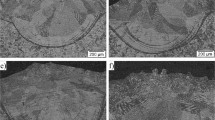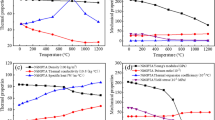Abstract
The thermal cycling in the coaxial laser cladding process can cause significant variations in the strength of cladded parts as well as the development of residual stresses, large distortions, and even cracking. In the current study, the hardness variations, induced residual stress distribution, and the developed distortion characteristics of cladded parts are examined for different deposition tool paths. The research is conducted by means of numerical simulations validated by experimental results for selected surface cladding deposition strategies. The specimens were made using P420 stainless steel powder clad onto an AISI 1918 substrate. In the previous studies by the authors, it was found that the transient thermal solution using a moving heat source simulation technique required several days of computational time for small cladded parts, making it impractical for industrial applications. In the present research work, a modeling approach using a steady-state thermal solution was proposed. This technique produced similar results for hardness and residual stress in a shorter time period, but the resulted distortion values were not accurate. Consequently, a thermo-mechanical modeling approach was adopted that provided virtual distortion solutions correlating well with the experimental results. These models were subsequently employed to explore various process planning scenarios. The effect of surface cladding deposition patterns, the substrate dimensions, the plate dimension’s aspect ratio, and the time gap between beads deposition were simulated and the strength and physical defects of the clad layer results are compared. Moreover, the mechanical response and properties for a full-scale gasket part is investigated as an example representing an industrial application.
Similar content being viewed by others
References
Cao S, Gu D, Shi Q (2017) Relation of microstructure, microhardness and underlying thermodynamics in molten pools of laser melting deposition processed TiC/Inconel 625 composites. J Alloys Compd 692:758–769
Nazemi N, Urbanic RJ, (2017) A numerical analysis approach to evaluate hardness and distortion for selected multi-track laser cladding configurations: P420 steel beed deposition on mild steel. ASME International Mechanical Engineering Congress and Exposition, November 3–9, Tampa, FL, USA
Weman K (2011) Welding processes handbook. Elsevier, Amsterdam, pp 188–190
Salonitis K, D’Alvise L, Schoinochoritis B, Chantzis D (2016) Additive manufacturing and post-processing simulation: laser cladding followed by high speed machining. Int J Adv Manuf Technol 85:2401–2411
Fallah V, Alimardani M, Corbin SF, Khajepour A (2011) Temporal development of melt-pool morphology and clad geometry in laser powder deposition. Comput Mater Sci 50:2124–2134
Hofman JT, Lange DF, Pathiraj B, Meijer J (2011) FEM modeling and experimental verification for dilution control in laser cladding. J Mater Process Technol 211(2):187–196
Nazemi N, Urbanic J (2016) A finite element analysis for thermal analysis of laser cladding of mild steel with P420 steel powder. ASME International Mechanical Engineering Congress and Exposition, November 11–17, Phoenix, AZ
Santhanakrishnan S, Kong F, Kovacevic R (2011) An experimentally based thermo-kinetic hardening model for high power direct diode laser cladding. J Mater Process Technol 211(7):1247–1259
Zhang Z, Farahmand P, Kovacevic R (2016) Laser cladding of 420 stainless steel with molybdenum on mild steel A36 by a high power direct diode laser. Mater Des 109:686–699
Chew Y, Pang JHL, Bi G, Song B (2015) Thermo-mechanical model for simulating laser cladding induced residual stresses with single and multiple clad beads. J Mater Process Technol 224:89–101
Farahmand P, Kovacevic R (2014) An experimental-numerical investigation of heat distribution and stress field in single- and multitrack laser cladding by a high-power direct diode laser. Opt Laser Technol 63:154–168
Gouge MF, Heigel JC, Michaleris P, Palmer TA (2015) Modeling forced convection in the thermal simulation of laser cladding processes. Int J Adv Manuf Technol 79(1):307–320
Nazemi N, Urbanic J (2017a) An experimental and simulation study for powder injection multi-track laser cladding of P420 stainless steel on AISI 1018 steel for selected mechanical properties. ASME J Manuf Sci Eng In press. https://doi.org/10.1115/1.4037604.
Nazemi N, Urbanic J, Alam M (2017b) Hardness and residual stress modeling of powder injection laser cladding of P420 coating on AISI 1018 substrate. Int J Adv Manuf Technol 93(1–19):3485–3503
Nazemi N, Alam M, Urbanic J, Saqib S, Edrisy A (2017c) A hardness study on laser cladded surfaces for a selected bead overlap conditions. SAE World Congress, Detroit
Nazemi N, Urbanic RJ, Saqib S (2017e) Utilizing a numerical simulation to model a step function response for 420 stainless steel powder laser cladding. ASME International Mechanical Engineering Congress and Exposition, November 3–9, Tampa, FL, USA
Heigel JC, Gouge MF, Michaleris P, Palmer TA (2016) Selection of powder or wire feedstock material for the laser cladding of Inconel. J Mater Process Technol 231:357–365
Zhao H, Zhang G, Yin Z, Wu L (2012) Three-dimensional finite element analysis of thermal stress in single-pass multi-layer weld-based rapid prototyping. J Mater Process Technol 212(1):276–285
Zhao H, Zhang G, Yin Z, Wu L (2011) A 3D dynamic analysis of thermal behavior during single-pass multi-layer weld-based rapid prototyping. J Mater Process Technol 211(3):488–495
Zhang CS, Li L, Deceuster A (2011) Thermomechanical analysis of multi-bead pulsed laser powder deposition of a nickel-based superalloy. J Mater Process Technol 211:1478–1487
Alimardani M, Toyserkani E, Huissoon J (2007) A 3D dynamic numerical approach for temperature and thermal stress distributions in multilayer laser solid freeform fabrication process. Opt Lasers Eng 45:1115–1130
Ding J, Colegrove P, Mehnen J, Williams S, Wang F, Almeida PS (2014) A computationally efficient finite element model of wire and arc additive manufacture. Int J Adv Manuf Technol 70(1–4):227–236
Ding J, Colegrove P, Mehnen J, Ganguly S, Almeida PMS, Wang F, Williams S (2011) Thermo-mechanical analysis of wire and arc additive layer manufacturing process on large multi-layer parts. Comput Mater Sci 50(12):3315–3322
Pu X, Zhang C, Li S, Deng D (2017) Simulating welding residual stress and deformation in a multi-pass butt-welded joint considering balance between computing time and prediction accuracy. Int J Adv Manuf Technol:1–12
Lei YW, Sun R, Tang Y, Niu W (2012) Numerical simulation of temperature distribution and TiC growth kinetics for high power laser clad TiC/NiCrBSiC composite coatings. Opt Laser Technol 44:1141–1147
Lie W, Ma J, Kong F, Liu S, Kovacenic R (2015) Numerical modeling and experimental verification of residual stress in autogenous laser welding of high-strength steel. Lasers Manuf Mater Process 2:24–42
Wang L, Felicelli S (2007) Process modeling in laser deposition of multilayer SS410 steel. J Manuf Sci Eng 129(6):1028–1034
Wen SY, Shin YC, Murthy JY, Sojka PE (2009) Modeling of coaxial powder flow for the laser direct deposition process. Int J Heat Mass Transf 52:5867–5877
Sowdari D, Majumdar P (2010) Finite element analysis of laser irradiated metal heating and melting process. Optics Laser Technol 42:855–865
Tabernero I, Lamikiz A, Ukar E, Lacalle LN, Angulo C, Urbikain G (2010) Numerical simulation and experimental validation of powder flux distribution in coaxial laser cladding. J Mater Process Technol 210(15):2125–2134
Acknowledgments
This research is funded by the Ontario Center of Excellence Collaborative Research program, Natural Sciences and Engineering Research Council of Canada through the Discovery Grant, and Mitacs. The authors would like to thank the industry sponsor, Mr. Robert Hedrick of Camufacturing Solutions Inc. for the partial funding and resources he has provided for this research project.
Author information
Authors and Affiliations
Corresponding author
Rights and permissions
About this article
Cite this article
Nazemi, N., Urbanic, R.J. A numerical investigation for alternative toolpath deposition solutions for surface cladding of stainless steel P420 powder on AISI 1018 steel substrate. Int J Adv Manuf Technol 96, 4123–4143 (2018). https://doi.org/10.1007/s00170-018-1840-1
Received:
Accepted:
Published:
Issue Date:
DOI: https://doi.org/10.1007/s00170-018-1840-1




